Visualizing Valor with Rajiv Eipe, Priyankar Gupta and Priya Kuriyan

Within the historic fabric of India's fight for independence, stories of numerous unsung heroes remain concealed in the farthest corners of our nation. These individuals—from remote forests, rogue villages, and even humble kitchens—wielded lathis, bombs, banners, and pens with unwavering courage, bringing the colonial empire to their knees.
In our dialogue with three illustrators, namely Rajiv Eipe, Priya Kuriyan, and Priyankar Gupta, we embark on a journey to unveil the creative process behind three stories featured within this collection.



“I have always felt the need to tell our indigenous stories.” Priyankar Gupta, a visual storyteller and educator, explains, “Finding your own voice and visuals to tell a story and not aping the west or far east is the key to original storytelling”.
Priyankar is the brains behind the portrayal of "The Magnificent Seven - Freedom Fighters of Badmash Gaon," a village where the challenges of caste discrimination were interwoven within the freedom struggle. A village that braved acts of heroism deeply rooted in Gandhian principles of Ahinsa (non-violence) and Satyagraha (the practise of truth).

A spread from " The Magnificent Seven - Freedom Fighters of Badmash Gaon," a narrative illustrated by Priyankar Gupta. This narrative depicts the quest for freedom as the village of Panimora grappled with the internal battle against caste biases.
Coming into the project through his previous engagement with the publication house, he captured Panimora ( Badmash Gaon) in the 1940’s and the resistance of its people- most famously, the seven revolutionaries, Chamaru, Dayanidhi, Madan, Jitendra, Chaitanya, Chandrashekar Sahu and Chandrashekar Parida.
He worked with an edited version of the original manuscript, tweaking the dialogues and descriptions alongside the visual narrative. Condensed in a 12 pager, the initial draft included thumbnail sketches and text boxes. This was later refined and made concise.

A preliminary version of " The Magnificent Seven - Freedom Fighters of Badmash Gaon " created during the project, with Priyankar conducting research and visually referencing villages in Orissa from the 1935-1940s in order to authentically capture the era.
“To be honest it was tough to depict something so real. These are stories which are a derivative of hard-core research.” Priyankar says as he illustrated the freedom fighters in the fervour of their youth. Taking creative liberties, and studying similar villages of Orissa, he recreated the village of Panimora from a bygone era. “Luckily the temple mentioned in the text has stood the test of time”, he adds.
Unlike the temple, the stirring stories of Panimora have fallen into silence.
Rajiv Eipe one of the minds behind the 16-narrative graphic anthology explained, “For our grandparent’s generation, the struggle for independence and the horrors of partition are lived experiences. For our parents, a new nation finding its feet and its place in the world. Many of our generation have had quite privileged and comfortable lives, I certainly have. So, it’s easy to lose perspective.”

Panels from the “H.S. Doreswamy; Mysore’s mischievous newsman”,the story of a journalist who ingeniously circumvented British press limitations, ensuring that local residents had access to information in their native language.
The award-winning illustrator and animator, Rajiv, rendered the story of “H.S. Doreswamy; Mysore’s mischievous newsman”, a journalist who outsmarted the British’s press restrictions by registering multiple Kannada newspapers- all featuring identical content.
“The photographs of Doreswamy that were shared gave a strong sense of the character.” he says. The spirited Doreswamy, seated slightly hunched on a chair, detailing his life, adds an emotionally resonant dimension to Rajiv’s narrative.
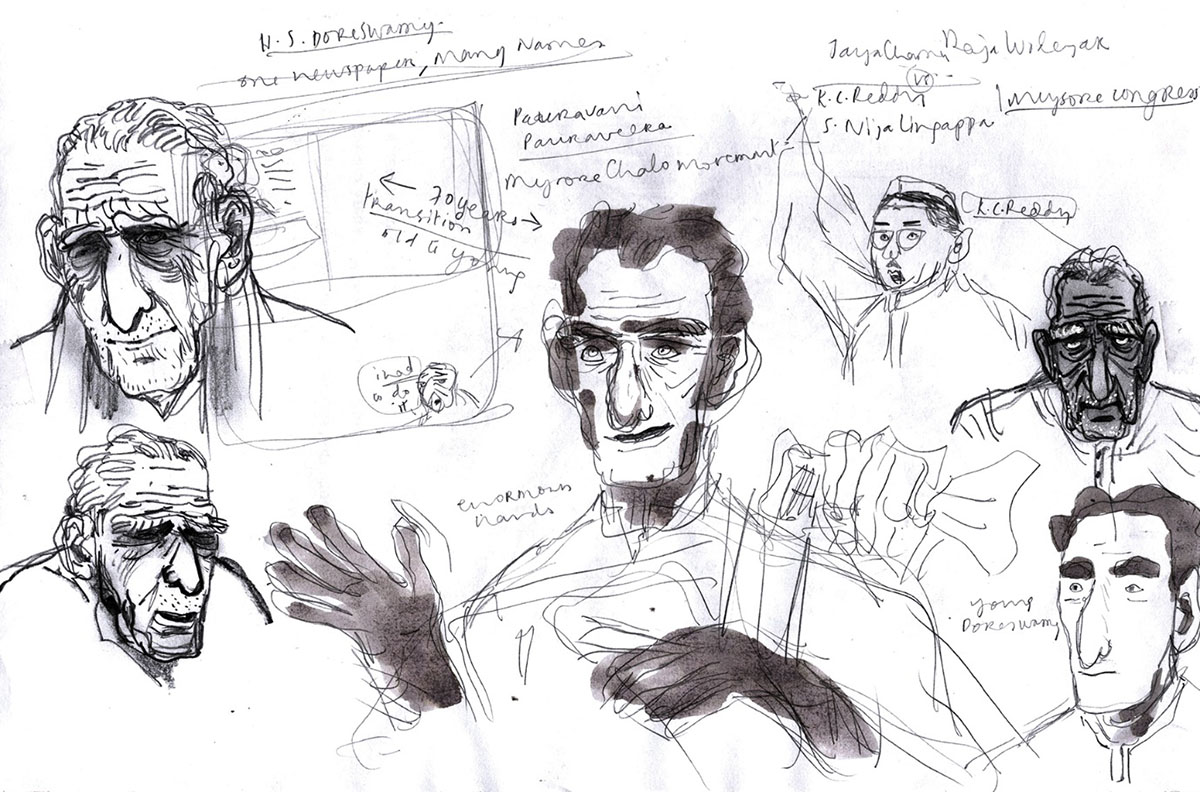
Rajiv's conceptual sketches of H.S. Doreswamy, inspired from photographs, included a simplification of Doreswamy's unique features, ensuring that his character remained recognizable across various historical periods.
Collaborating closely with Aditi Chandrasekhar, the editor, under tight deadlines, Rajiv began comprehending the character, the setting, and the narrative flow through rough thumbnail sketches accompanied by unedited text from the original story.
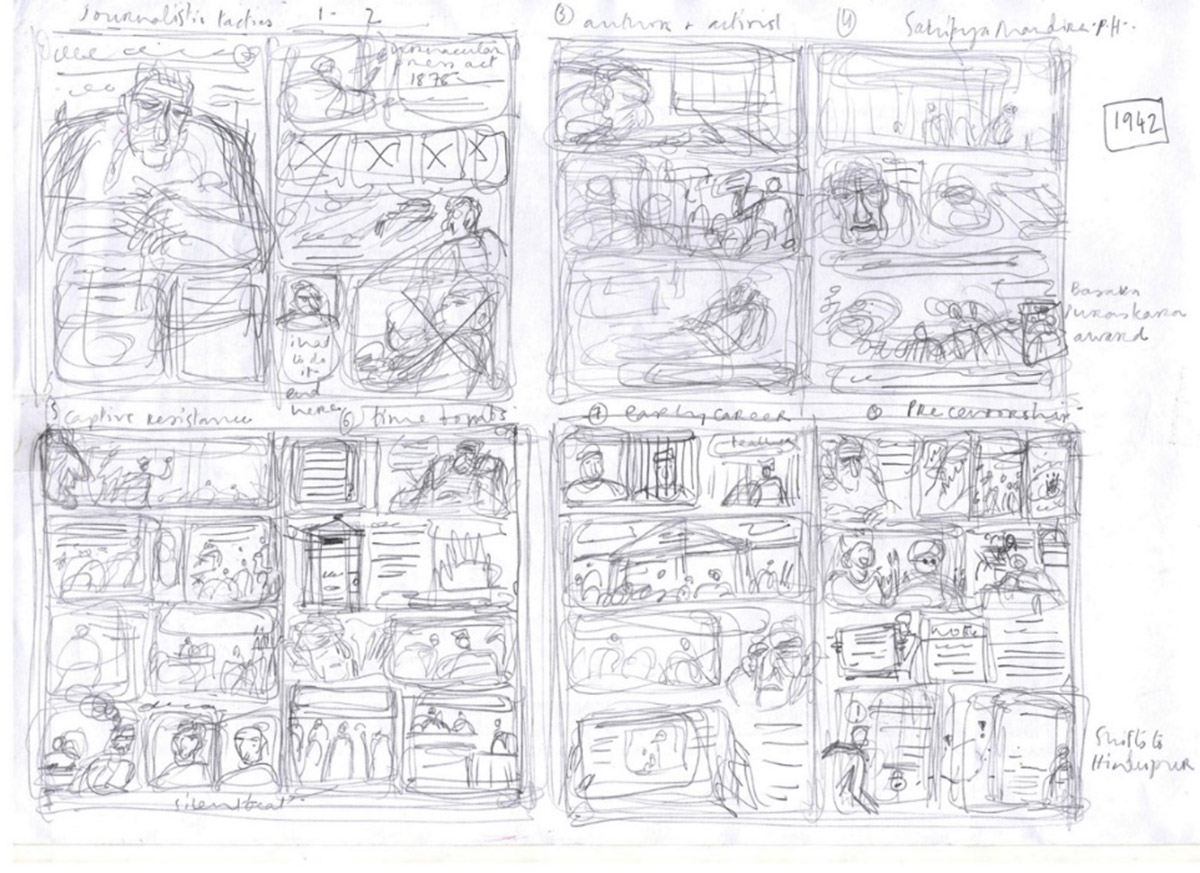
The initial sketches created by Rajiv helped understand the layout and composition of the panels and spreads.
“I was hesitant to edit the text too much for fear of losing the ‘voice’ of the author P. Sainath, as well as the voice of the protagonist of the story, H S Doreswamy, both of which were both quite apparent in the original story.”
Iteratively working through a text-heavy first draft, the team was able to capture the essence of Doreswamys’ story in a seven-page narrative.

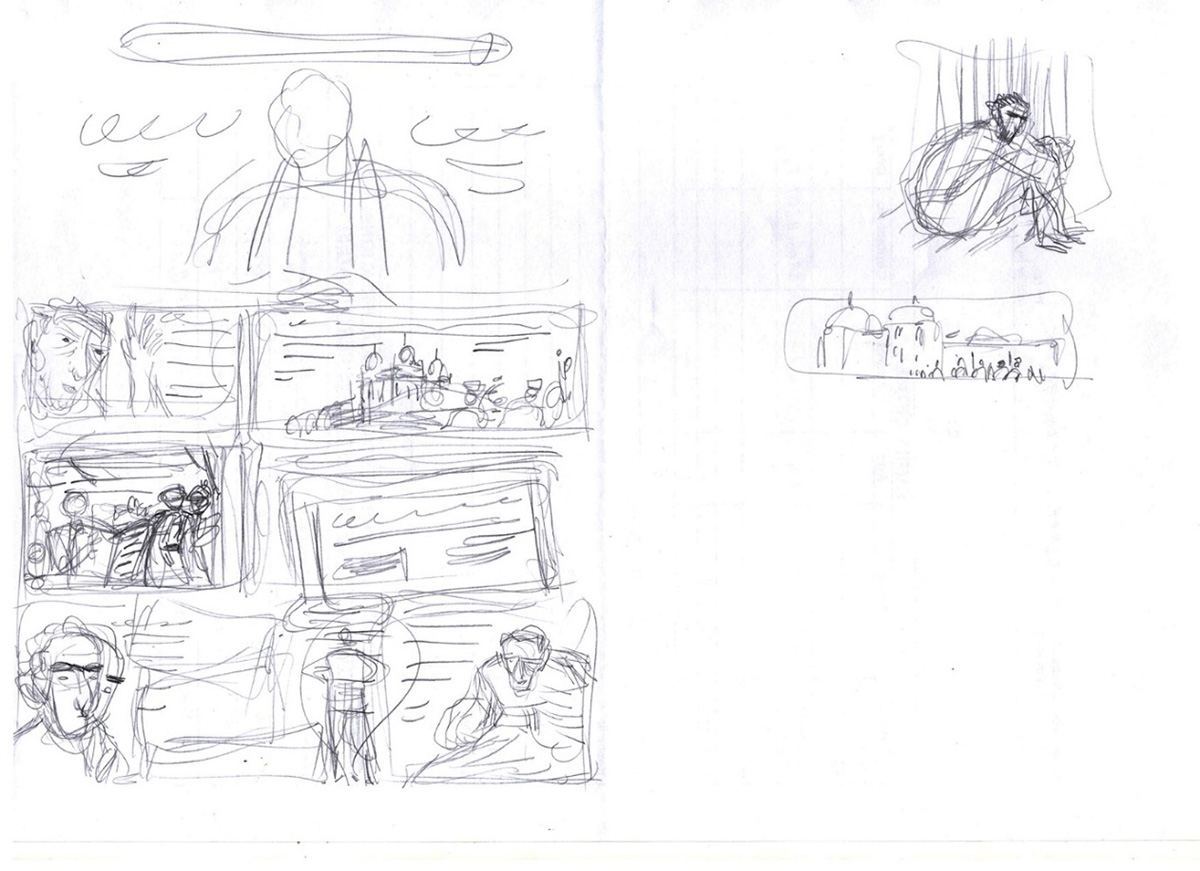
The preliminary sketches created by Rajiv helped recognise the text-heavy nature of the project, he focused on creating simple and clear visuals, ensuring that they complemented the storytelling and did justice to Doreswamy's story.
The distinctive features of Doreswamy - hooked nose, bushy eyebrows, and broad shoulders were abstracted to help Rajiv achieve consistent identification of the character throughout the story. “I was conscious of making sure the images were simple and clear enough to not hamper the storytelling in any way. ”, Rajiv says.
Detailing the world of Doreswamy didn’t come without its own set of challenges. Often, there were gap in the visual referencing for the era. Rajiv says, “I relied on internet searches, often disappearing down rabbit holes while looking up mundane things like ‘what did post boxes look like in India in the 1940s’.”

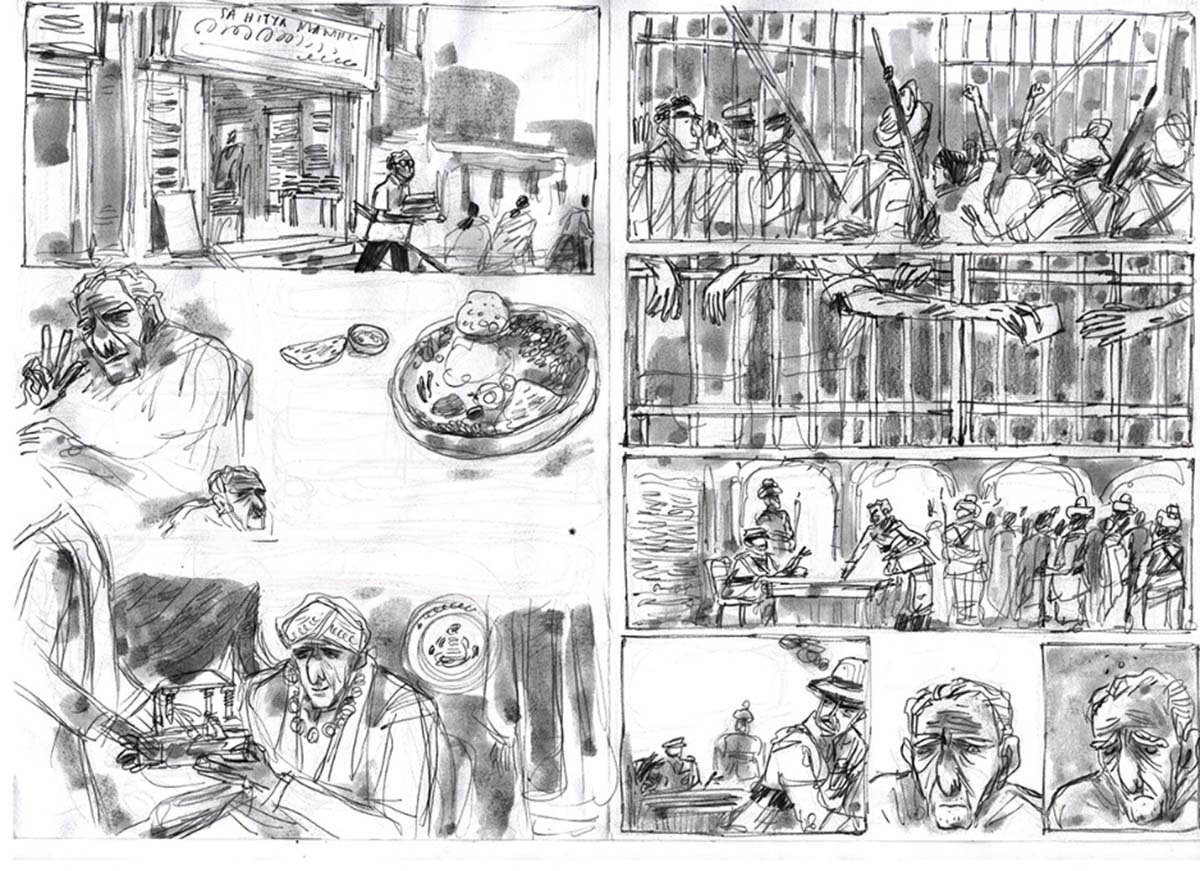

Inked sketches of the panels sans text created by Rajiv. He relied on Google searches to help understand the prison uniforms, architecture, and available technologies of the era. Arriving at a style that didn’t make these things look too conspicuous was something that helped immerse the reader into the time period.
An activist's life, such as Doreswamy's, also brought consequences for his family. Scarce financial resources nearly forced his son to leave college, and his wife, Lalithamma, bore the entire burden of household responsibilities on her own.

“Women's work in India is taken for granted to such an extent, that women themselves invisibilise their own contributions to society”, says Priya Kuriyan, who is a children’s book writer-illustrator and comics maker. She is the illustrious mind behind “Bhabani Mahato: Feeding the Revolution in Puruliya”, the story of a woman who worked tirelessly to fuel the revolution in the remote Chepua village of Puruliya district of West Bengal.
Amidst the domestic work, the British surveillance and The Bengal Famine, Bhabani and many other women cooked for the growing number of revolutionaries of the underground resistance who hid in the forests near Puruliya.

A spread from " Bhabani Mahato: Feeding the Revolution in Puruliya " which narrates the tale of a woman who selflessly provided nourishment to revolutionaries on the run or hidden in forests. During Priya's research on Bhabani, she encountered a striking absence of information about the figure, which strengthened her determination to bring this story to life through illustration.
“The idea of feeding someone who is hungry is such a basic act of love and for her it was given that she would feed anyone who needed to be fed; revolutionaries or not.” Priya says as she sought to bring forth the hardships of Bhabani whose fierce body language radiated even through the lines on her weathered skin, a visage toughened with time.
“I really wanted to capture how busy and challenging her life was, which is why there are panels in which she appears multiple times in one frame and other visual metaphors that drive that point forward.” Says Priya.

Priya crafted illustrations for Bhabani's story by interpreting the text and incorporating visual elements that enriched Bhabani's character and surroundings. She delved into the subtleties of the narrative to vividly convey the fiery persona of Bhabani.
Starting with doodling out the character and simultaneously planning out the comic using small thumbnails, Priya and the editors took decisions like the number of pages and the number of panels per page.
She studied visual references from the freedoms struggle and clarified other visual details of the era with P.Sainath to add depth to the comic. Working with text and dialogue juxtaposed with rough black and white sketches, she created the final flow using a combination of hand drawn and digital shading techniques.
Priya says, “There were bits in the original text that describe her body language; how she forcefully pushes her hand forward while making a point. Those gave me an idea as to what a firebrand she must be.”.
“Whenever one is working on a piece about someone who actually exists or existed, there is the additional pressure that the person might actually see the piece. Hopefully Bhabani Mahato will approve.” Priya adds.

Sketches of Priya's portrayal of Bhabani's story were deliberately designed with multiple appearances of her within each frame and across panels. This choice aimed to vividly depict the challenges of both nourishing a group of 15-20 individuals as well as managing cultivation simultaneously.
Overcoming the challenges of visual referencing, illustrators Priyankar, Rajiv, and Priya skilfully crafted a compelling graphic narrative that takes us through the extraordinary determination of three not-so-ordinary characters.
“It was such an audacious idea to believe that a diverse population such as ours came together as one country. Unless we continue to record and share what that time was like and celebrate it, future generations would not know what a precious and fragile thing we have inherited.” says Priya.
“Projects like these of Unknown Heroes, Stories from the Heartland and more multilingual content will hold the history. History should be taught beyond the textbooks. They are true stories at the end of the day” Priyankar says.
And as storytellers, Priyankar believes expanding the avenues of visual narratives while collaborating with exhibition designers, game designers, NGOs, and wherever a need arises, can turn any opportunity into one for illustrations.
”As hard as it is to make a career in illustration financially sustainable, I’d recommend making an effort to always strive for excellence. Don’t do a half-baked job and rationalise it by saying the money wasn’t good enough, I don’t think that helps.” Rajiv says.
Priya believes that practising the craft every day, staying alert, gaining insight into the context you're operating within, reading, being interested in people and their stories, and immersing oneself in natural environments regularly are all ways to work on one’s craft.

As citizens of today’s India, Rajiv feels that we should strive to realize the ideals of justice, liberty, and equality. “I disagree with the hard-nosed nationalism and majoritarianism of the central establishment, the personality-cult politics, the propensity to muzzle dissent, push through legislation without building consensus, and in general their rather narrow idea of what it is to be Indian.” he says.
“There seems to be a forced 'oneness' that is at odds with the idea of fraternity that our founding fathers espoused. And that is something that makes me most uncomfortable”, Priya says about the media-driven narrative of the current system that seems to her; more exclusionary than inclusive.
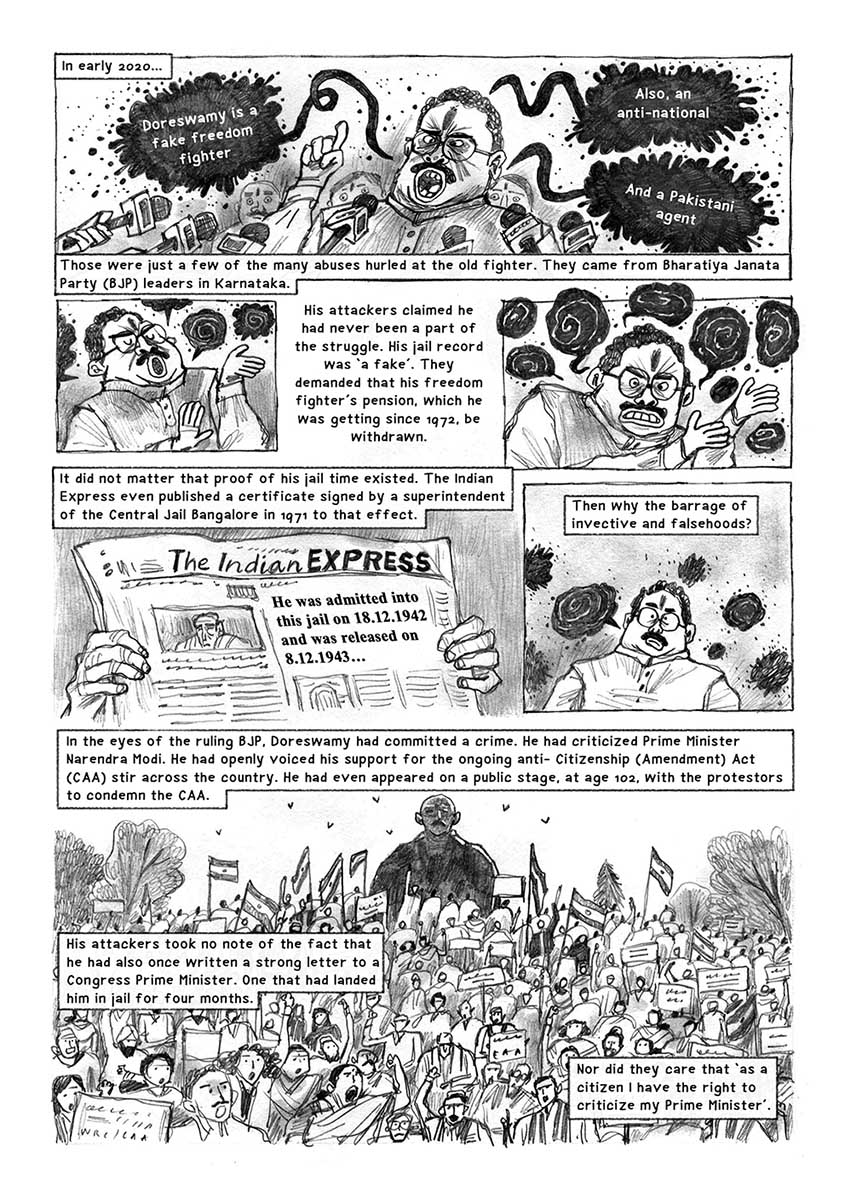
Amidst the hustle of everyday life, we often overlook the fact that we stands on the might of countless individuals - ranging from brave foot soldiers to legendary visionaries- who played pivotal roles in India's path to independence
Rajiv encourages us to gain a deeper understanding of our complex history through reading and honour the freedom struggle.
Priyankar believes with the inclusion of design, art, music and theatre into our schools, young minds would grow as well-rounded individuals. He wishes that everyone contributes selflessly in any modest capacity, with the aspiration of preserving the distinctive social tapestry of our truly exceptional subcontinent.
Priya says, “As storytellers, and communication designers we could perhaps tell more stories that redefine the idea of what it means to love our country. Set a counter narrative that celebrates a kinder and more compassionate nation.”
With that thought, we come to end of this insightful conversations with talented illustrators, Rajiv Eipe, Priyankar Gupta and Priya Kuriyan. They breathed new life into the narratives of our freedom struggle illuminating the profound impact that art and storytelling can have in preserving our history and inspiring future generations.
You can find the link to other exciting projects and updates by them on the links below.
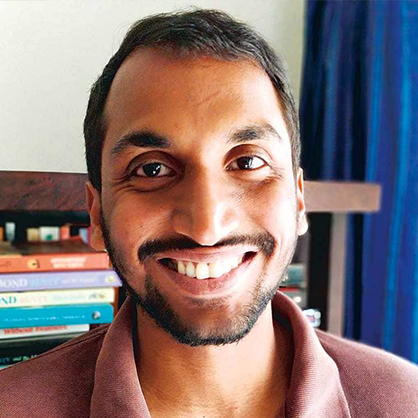
RAJIV EIPE
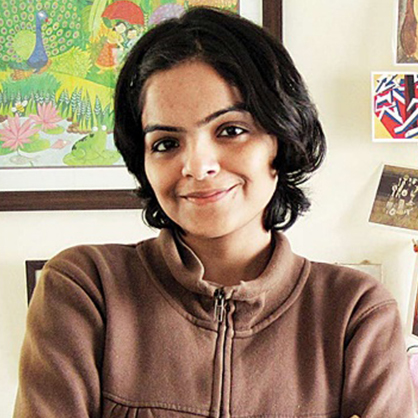
PRIYA KURIYAN
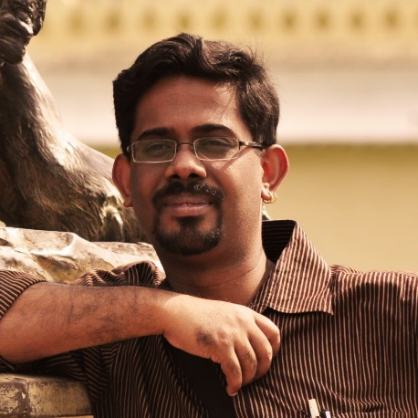
PRIYANKAR GUPTA

